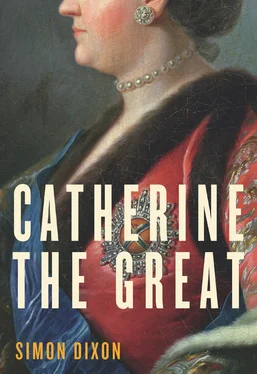If Catherine shared any of these concerns—and it is difficult to imagine that they wholly escaped her—then she was careful to give no sign of it. Optimistic by nature, she spent her final week in Moscow cementing her links with favoured courtiers by touring their country estates. On 7 June, after lunch at Znamenskoye with the Chief Cup-Bearer, Alexander Naryshkin, she took a stroll through the garden to see the museum where her host preserved a treasured yacht built before the foundation of the Russian fleet in the early 1690s. From there, it was but a short journey to inspect the troops on exercise in the neighbouring fields. Having dined at Pokrovskoye with the Master of the Horse, Lev Naryshkin, she returned to her palace along a route illuminated by extravagant fireworks. Two days later, she drove out to Tsar Boris’s ponds, eight miles from the city centre, where she kissed the icons in the local church before watching the fishing. Then it was Peter Sheremetev’s turn to entertain her at Kuskovo, one of Russia’s most opulent estates, where a magnificent orangery was currently under construction. They sailed on the lake before playing cards; it was two in the morning before she got back to Moscow. There was still time for a final afternoon’s hawking before the Court departed for Tsarskoye Selo on Saturday 14 June. After a journey punctuated by the customary visits to churches and monasteries, it was one of Catherine’s first priorities to check on the progress of her new dacha at Oranienbaum, where she travelled ‘with the smallest possible entourage’ on 25 June. 4
Any residual anxieties were masked by her ceremonial re-entry into the capital on Saturday 28 June, the first anniversary of Catherine’s accession. There could hardly have been a greater public display of self-confidence. 5Bathed in the cool glow of the midsummer ‘white nights’, more than 11,000 soldiers lined the streets to salute the procession. As her open carriage rolled over the Obukhov bridge at 7 p.m., three cannon fired to signal the start of a carillon across the city. Seventy-one guns roared from the Admiralty and seventy more from the Peter and Paul fortress as the empress and her Court were led past the cheering crowds by a detachment of mounted cavalry. In the Haymarket, at the junction of Pea Street and Garden Street, Savva Yakovlev, an ennobled merchant of fabulous wealth, had hoisted a crown onto the main cupola of his new Church of the Dormition to mark the completion of the exterior in the year of her coronation. 6When the procession reached the Kazan Church, Catherine descended from her carriage to meet Archbishop Gavriil and paused briefly for prayers while seminarians from the Alexander Nevsky monastery chanted salutations from platforms raised on either side of the great door. Her emergence from the church triggered a second, longer salute as she continued along the Great Perspective Road to meet the city’s merchants, who turned out in force at Gostiny dvor, a vast covered market. At the Anichkov Palace, it was the turn of Prince Nikolay Repnin and the Cadet Corps to greet her. Only when she reached the Summer Palace did a final 101-gun salute issue from the fortresses. Three times the cry went up: ‘Vivat, Yekaterina: Great Empress!’ Then she passed inside to permit the foreign diplomats assembled in the throne room to kiss her hand. 7
After dining alone, Catherine emerged from her apartments just before midnight to stroll through the Summer Gardens to the riverbank where Colonel Melissino was ready to set off one of Jacob Stählin’s most extravagant firework displays. The first rockets went up as soon as she had taken her place in a baroque wooden gallery, built in short order by carpenters from the Admiralty College according to designs sent up from Moscow. 8‘Vigilance and Virtue’ was the theme of the first scene, set in the temple of Pallas, where the goddess fired thunderbolts from her perch in the clouds, brandishing in her left hand a sceptre with the Russian coat of arms and in her right the head of Medusa to ward off her enemies. ‘Glory’ was the slogan emblazoned on a temple flanked by allegorical figures of Wisdom and Courage; ‘Astonishment’ the name of an obelisk celebrating Catherine’s prowess as a female sovereign. No sooner had the smoke from this first tableau cleared than the scene changed to reveal a forest of luxuriant palm trees on ‘the island of scholarship and amusement’. This time the subject was ‘Wisdom and Clemency’ and the empress was represented as Minerva, the helmeted goddess of wisdom. 9Even the hostile French attaché had to concede that the whole evening had been ‘a very brilliant and well organised spectacle’. 10And no one could miss its central message: here was a ruler whose maternal gentleness was not to be mistaken for weakness. On the contrary, she had every intention of deploying knowledge and reason in the service of her formidable empire.
* * *
Proud and imperturbable in public, Catherine was well aware of the scale of the challenge she faced in restoring order and prosperity to her empire in the aftermath of the Seven Years’ War. In the wake of that gruelling conflict, every state in Europe faced a period of tough internal consolidation. Russia was no exception. Over the next few years, Catherine would write several memoranda bemoaning the legacy she had inherited: ‘the fleet was derelict, the army in disarray, the fortresses collapsing’; the treasury was in arrears, though no one could tell her by how much; the prisons were overflowing (she secretly arranged for minor debtors to be released); corrupt officials were everywhere despised; and parts of the countryside were in open revolt. 11No state could have survived for long the massive peasant unrest that characterised Catherine’s early years on the throne. 12Fortunately for her, most Russian peasants had more to gain from violence against each other than from risky attempts to overthrow the authorities. Once the major incidents had been summarily put down, the empress turned her mind to more fundamental change. Although serfdom was far too integral to Russian political culture to allow for wholesale emancipation of the serfs, an audience with Pastor Eisen in October 1763 may have persuaded her to try out his controversial ideas for a free, property-owning peasantry on the crown estate at Bronnaya, beyond Oranienbaum. Though it ultimately proved too small for the purpose, Eisen soon discovered that the greatest obstacle to imperial initiatives was presented by officials hostile to change. ‘Not only has Hell in its entirety opened up against me,’ he told a fellow pastor in January 1764, ‘but devilish extraordinary chance events have occurred which have really put me in the firing line. If the ground underneath me were not so secure, I should long since have broken my neck.’ 13
One excuse offered to Eisen in explanation of the delays was that Catherine was too busy with other projects to attend to his own. There was some truth in that. No sooner had she seized the throne than the pace was set for a sustained burst of reforming energy which on average saw almost twice as many edicts issued each month between 1762 and 1767 as in the reign as a whole. 14Since her main aim was to change her subjects’ hearts and minds, popular education—a subject all the rage in Europe in the wake of Rousseau’s Emile (1762)—was at the forefront of her priorities. Over the next few years, she commissioned a wide range of projects, many of which drew on the interest in the subject that had flourished in Russia since the end of the previous decade. Daniel Dumaresq, a former chaplain to the British Factory in St Petersburg, returned in 1764 bearing information about a variety of English and Irish institutions, ranging from Moravian boarding schools to the dormitories at Eton. He was personally acquainted with Catherine and spent time with Grand Duke Paul while he devised a ‘General Plan of Gymnasia’, completed two years later. 15By that time, however, Catherine had placed her trust in a rival scheme devised by her mother’s old paramour, Ivan Betskoy. Authorised to admit destitute and illegitimate children without question, his Moscow Foundling Home, opened on her thirty-fifth birthday in 1764, was intended to foster the creation of a wholly ‘new kind of people’, raised in isolation from the damaging influence of a backward Russian environment according to an ambitious curriculum set out in Betskoy’s General Plan for the Education of Young People of Both Sexes . This remarkable document envisaged nothing less than a new generation of Russians imbued with a high moral sense of duty to the fatherland and to their fellow men. 16Betskoy believed that the empire’s greatest need was for the sorts of artisan and craftsman who could supply the ‘third estate’ that Russia notoriously lacked. He drove the point home to Catherine by giving Paul a carpenter’s bench for the Winter Palace, where a French master carpenter was employed to teach him. 17
Читать дальше












